Discover the perfect camping style to match your outdoor spirit, whether you’re a first-time adventurer Learning to Camp or a seasoned wilderness explorer. From the rugged simplicity of backpacking to the luxurious comfort of glamping, modern camping has evolved far beyond the traditional tent-in-a-field experience. Today’s campers can choose between off-grid backcountry adventures, fully-equipped RV sites, cozy cabin stays, or even suspended tree camping – each offering a unique way to connect with nature while respecting new environmental guidelines and park regulations.
As more people seek outdoor escapes, understanding these distinct camping styles helps ensure you select an experience that matches both your comfort level and the latest conservation rules. Whether you’re planning a quick weekend getaway or an extended wilderness expedition, knowing the key differences between camping types will help you prepare appropriately and maximize your outdoor adventure while minimizing your environmental impact.
Frontcountry Camping: The New Normal
Modern Amenity Guidelines
Today’s camping experience blends outdoor adventure with modern conveniences, but it’s essential to follow new guidelines for responsible resource use. When planning your frontcountry camping essentials, be mindful of electrical usage limits – most sites now restrict power consumption to 30 amps per site to prevent grid overload during peak seasons.
Water conservation is another priority, with many campgrounds implementing timed showers and requesting campers to use biodegradable soaps. Some sites have introduced smart meters to monitor usage, ensuring fair distribution among all campers.
Facility access has also evolved, with many campgrounds now offering online booking systems for amenities like shower blocks and laundry facilities. Remember to download your campground’s app if available – it’s often required for accessing modern amenities and receiving important updates about facility maintenance or temporary closures.
Pro tip: Pack a portable solar charger for your devices. It’s eco-friendly and ensures you’re not dependent on campground power sources!
Noise and Quiet Hours
Quiet time is a crucial part of the camping experience, and most campgrounds enforce quiet hours from 11 PM to 7 AM. During these hours, all campers should minimize noise, including conversations, music, and recreational activities. Generator use has new restrictions across many Ontario parks, with operation permitted only between 9 AM and 9 PM. Some sites now designate generator-free zones for those seeking a more peaceful experience.
Pro tip: If you need power during quiet hours, consider investing in solar-powered equipment or battery banks. These silent alternatives help maintain the tranquil atmosphere that makes camping so special. For evening activities, opt for quiet games, stargazing, or storytelling around a low-volume campfire gathering.
Remember that sound carries surprisingly well in outdoor spaces, especially across water. Even during regular hours, keep music at a reasonable level and be mindful of neighboring campers who might be seeking solitude in nature.
Backcountry Camping Regulations
Leave No Trace 2.0
Modern camping demands a more comprehensive approach to environmental stewardship. While traditional Leave No Trace principles remain crucial, today’s campers need to embrace additional practices to protect our natural spaces. Start by choosing eco-friendly camping gear made from sustainable materials and designed for longevity.
Consider using biodegradable soap and bringing a portable water filter instead of plastic bottles. Pack a dedicated waste sorting system with separate bags for recyclables, compostables, and trash. Remember to collect and properly dispose of micro-trash like twist ties and fruit stickers that often get overlooked.
Digital mapping has made it easier to stay on marked trails, reducing habitat disruption. Take photos of your campsite upon arrival and ensure it looks identical when you leave. Pro tip: Bring a small rake to restore any compressed soil and scattered leaves to their natural state.
When gathering firewood, collect from multiple areas to prevent concentrated impact. And here’s something many forget – check your tent and gear for hitchhiking seeds or organisms before moving between camping locations to prevent spreading invasive species.
Wildlife Protection Updates
Keeping our wildlife safe has never been more important, and recent updates to camping regulations reflect this priority. All campers must now use bear-resistant food storage containers or park-provided food lockers, regardless of their camping style. Gone are the days of storing snacks in your tent – even toothpaste and scented items need proper storage!
If you encounter wildlife, the new protocol is simple: maintain at least 100 meters distance from large animals like bears and moose, and 30 meters from smaller wildlife. Never feed wild animals, as this can make them dependent on human food and create dangerous situations for future campers.
Remember to pack out what you pack in, including food scraps that might attract animals. Many campgrounds now require campers to document any wildlife sightings through their mobile apps – this helps rangers track animal movements and protect both wildlife and campers.
Pro tip: Consider bringing a bear bell or whistle, especially when hiking to your campsite. The sound alerts animals to your presence, giving them time to move away naturally. This simple step has become standard practice among experienced campers in Ontario’s wilderness areas.
Group Camping Evolution
Size Restrictions
Recent changes to camping regulations have introduced new limits on group sizes and campsite allocation across Ontario’s parks and recreational areas. Most frontcountry campgrounds now restrict group sizes to six people per site, with some locations allowing up to eight if they’re from the same household. For backcountry camping, groups are typically limited to nine people to minimize environmental impact and preserve the wilderness experience.
Some popular camping destinations have implemented reservation windows and site rotation policies to ensure fair access for all campers. You’ll now need to book your site within specific timeframes, usually opening 5 months in advance for provincial parks. Sites are also being allocated with more space between them, offering better privacy and reducing noise levels between camping groups.
Pro tip: For the best chance at securing your preferred site, mark your calendar for the reservation opening dates and book early, especially for summer weekends and holidays. Remember to check specific park guidelines, as size restrictions may vary by location and season.
Shared Facility Rules
When camping in shared facilities, remember that a little courtesy goes a long way! Most campgrounds now require quiet hours from 10 PM to 7 AM, so keep those late-night stories and singalongs at a reasonable volume. Shared washrooms and shower facilities typically operate on a first-come, first-served basis, with designated cleaning times posted at the entrance.
For communal cooking areas and fire pits, there’s usually a 2-hour maximum usage time during peak periods. Remember to clean up thoroughly after use and properly dispose of your waste in designated bins. Many campgrounds now require advance booking for group pavilions and picnic areas, especially on weekends.
Keep your pets leashed in common areas and clean up after them immediately. For shared water sources, use only designated spots for dishwashing and avoid using soap directly in lakes or streams. Most importantly, respect the campground’s recycling guidelines and pack out what you pack in to help preserve these beautiful spaces for everyone to enjoy.
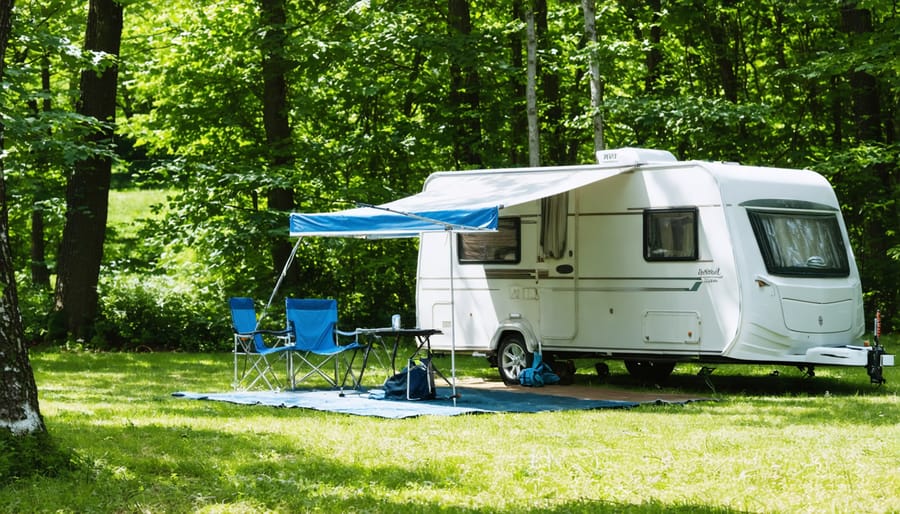
RV and Trailer Camping Updates
Power and Hookup Changes
Modern camping has evolved significantly when it comes to power needs and hookup requirements. Many campgrounds now offer enhanced electrical services to accommodate everything from phone charging to full RV setups. Before heading out, make sure to check the latest RV camping guidelines for your chosen destination, as power limitations vary by site type.
Most serviced sites now feature 30-amp connections, though some premium spots offer 50-amp service for larger rigs. It’s worth noting that many parks are implementing “quiet hours” for generators, typically from 10 PM to 7 AM, to maintain the peaceful nature experience. Some eco-friendly campgrounds are also introducing solar-powered charging stations and USB ports at common areas.
Pro tip: Always bring a surge protector for electrical hookups and consider investing in portable solar panels as a green backup option. This way, you’ll stay powered up while minimizing your environmental impact.
Length and Size Regulations
Before setting up camp, familiarize yourself with the latest vehicle and equipment size regulations. Most Ontario campgrounds now limit RVs and trailers to a maximum length of 32 feet, though some premium sites can accommodate units up to 45 feet. Standard parking spots typically measure 20 feet wide by 40 feet deep.
For tent camping, ensure your setup (including guy lines and accessories) fits within the designated 20′ x 20′ pad area. Pop-up campers and small trailers should note that many backcountry sites have size restrictions of 13 feet or less to protect natural surroundings.
Here’s a helpful tip: Always check specific campground websites for their size charts, as limits can vary between parks. Some locations offer pull-through sites for larger vehicles, but these are limited and should be reserved well in advance. Remember that exceeding size limits isn’t just about fitting into your spot – it’s about safely navigating park roads and protecting our natural environment.
Seasonal Camping Policies
Duration Limits
Recent changes to Ontario’s camping regulations have introduced new stay limits across different camping types. Most provincial parks now restrict continuous stays to 21 days at a single site, helping ensure fair access for all campers during peak seasons. For backcountry camping, stays are typically limited to 16 consecutive nights, while car camping spots can be booked for up to two weeks at a time.
Crown land camping follows a different set of rules, with a maximum stay of 21 days in one location per calendar year. After this period, campers must move at least 100 meters to a new spot. Some private campgrounds offer extended seasonal stays from May to October, perfect for those seeking a summer-long outdoor experience.
Pro tip: Book well in advance, especially for popular spots during summer weekends and holidays. Many campgrounds now use online reservation systems that open 5 months ahead, and the best sites often get snapped up within minutes of becoming available. Consider mid-week camping for better site availability and a more peaceful experience.
Site Maintenance Requirements
Seasonal campers need to stay on top of their site maintenance responsibilities throughout their stay. Keep your campsite clean and tidy by regularly removing trash, maintaining your fire pit, and trimming any overgrown vegetation. Check your site’s electrical connections monthly and report any issues to park staff immediately. During wet seasons, ensure proper drainage around your RV or trailer to prevent water damage and soil erosion.
Store all camping equipment, outdoor furniture, and recreational items properly when not in use. Many parks now require seasonal campers to perform periodic deck and shed inspections to ensure structural integrity. Remember to mow your site’s grass regularly during growing seasons, typically maintaining a height of 4-6 inches.
Be mindful of your neighbors by keeping noise levels reasonable and maintaining appropriate spacing between sites. Consider using eco-friendly cleaning products and implementing water conservation practices to minimize your environmental impact. Most importantly, document all maintenance activities in case of inquiries from park management.
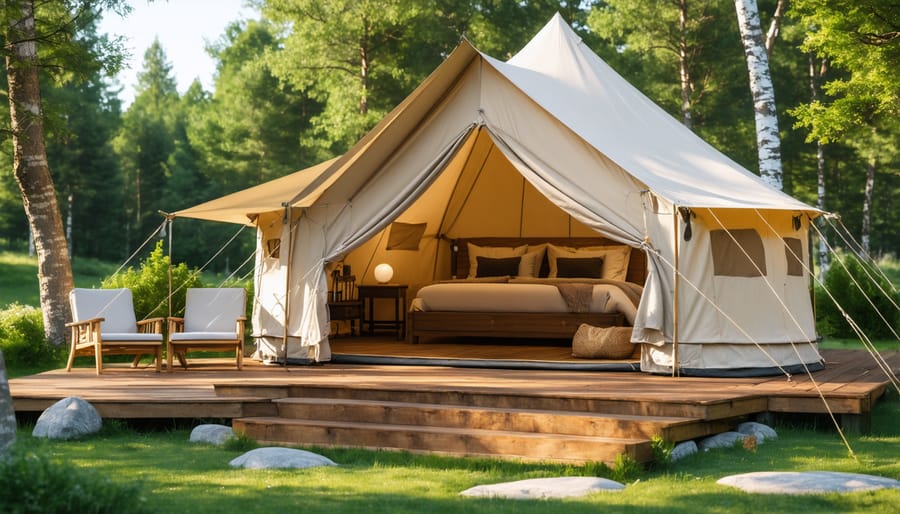
Glamping Guidelines
Structure Requirements
Recent updates to camping regulations have introduced new requirements for semi-permanent structures at campsites. If you’re planning to set up a long-term camp, your structure must now be easily dismantled and leave minimal environmental impact. Temporary shelters can’t exceed 10 square meters and must use removable anchoring systems rather than permanent foundations.
Pro tip: Consider using adjustable pole systems and weather-resistant fabric that can be quickly taken down. All structures need proper ventilation and must be at least 3 meters away from neighboring sites. For safety, ensure your setup includes clearly marked entry and exit points.
Remember to check with local authorities before building any semi-permanent structures, as specific requirements may vary by region. Most campgrounds now require a permit for stays longer than 14 days with such structures. Keep your impact low by using eco-friendly materials and following leave-no-trace principles when dismantling your camp.
Amenity Restrictions
Each camping style comes with its own set of amenity limitations that you’ll need to consider before heading out. Primitive camping means saying goodbye to running water, electricity, and modern bathrooms – you’re truly embracing the wilderness! Backcountry sites typically offer no facilities whatsoever, while frontcountry campgrounds usually provide basic amenities like outhouses and water taps.
RV camping might seem luxurious, but many campgrounds have restrictions on generator use and quiet hours. Glamping sites, while comfortable, often limit access to certain modern conveniences to maintain an authentic outdoor feel. Car camping areas usually offer shared facilities but may restrict the use of personal electrical equipment.
Remember, these limitations aren’t downsides – they’re part of what makes camping special! Many campers find that fewer amenities lead to a more genuine connection with nature. Just be sure to check specific site restrictions when booking, as they can vary significantly between locations and seasons.
Pro tip: Pack a solar charger and portable water filter to stay comfortable while respecting amenity restrictions.
Winter Camping Protocols
Safety Requirements
Winter camping brings exciting challenges, but new safety requirements ensure you’re well-prepared for the adventure. Always carry a fully charged satellite phone or emergency communication device – it’s now mandatory for overnight winter camping in Ontario’s backcountry. Pack enough emergency supplies for at least 72 hours, including high-calorie food, water, and extra warm clothing.
Your winter camping checklist must include a detailed trip plan filed with park authorities and a trusted contact. Bring a four-season tent, sleeping bag rated for -30°C or lower, and multiple heat sources. Remember, the new guidelines require campers to carry avalanche safety gear when camping in designated avalanche-risk areas.
Check weather forecasts regularly and be prepared to adjust plans accordingly. Travel in groups of three or more during winter months, and ensure at least one member has wilderness first aid certification. Keep emergency supplies in an easily accessible location, and know the coordinates of the nearest emergency shelter or ranger station.
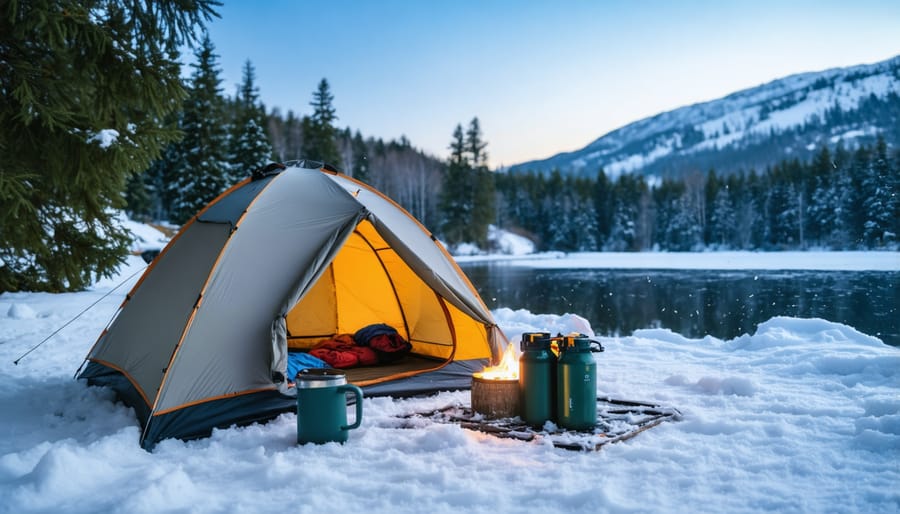
Equipment Standards
When gearing up for cold weather camping, having the right equipment isn’t just about comfort – it’s essential for safety. Modern camping standards now require all winter campers to carry a four-season tent rated for extreme temperatures, sleeping bags with a minimum temperature rating of -20°C, and insulated sleeping pads with an R-value of 4.0 or higher. For a complete checklist of winter camping gear essentials, refer to our detailed guide.
Don’t forget multiple layers of moisture-wicking clothing, emergency communication devices, and at least two reliable heat sources. A well-insulated water storage system is now mandatory to prevent freezing, and all campers must carry emergency shelter materials like space blankets and extra tarps. Pro tip: pack your gear in waterproof stuff sacks and keep electronics in insulated containers to protect batteries from the cold. Remember, these requirements aren’t just guidelines – they’re updated standards designed to keep you safe in Ontario’s winter wilderness.
Whether you’re drawn to the rustic charm of traditional tent camping or the luxury of glamping, there’s a camping style that perfectly matches your outdoor aspirations. From the self-sufficient adventures of backcountry camping to the social atmosphere of group camping, each type offers a unique way to connect with nature and create lasting memories.
Remember to always check local regulations before planning your trip, as rules can vary between parks and seasons. Stay informed about fire bans, permits, and seasonal restrictions to ensure a safe and legal camping experience. Consider the environmental impact of your chosen camping style and follow Leave No Trace principles to preserve these beautiful spaces for future generations.
Don’t be afraid to try different types of camping as you develop your outdoor skills. Start with car camping to build confidence, then gradually explore more adventurous options. Join local camping groups or take guided trips to learn from experienced campers. Most importantly, choose the camping style that brings you joy and allows you to experience the great outdoors in your own way.
Now that you’re familiar with the various camping options available, it’s time to start planning your next adventure!

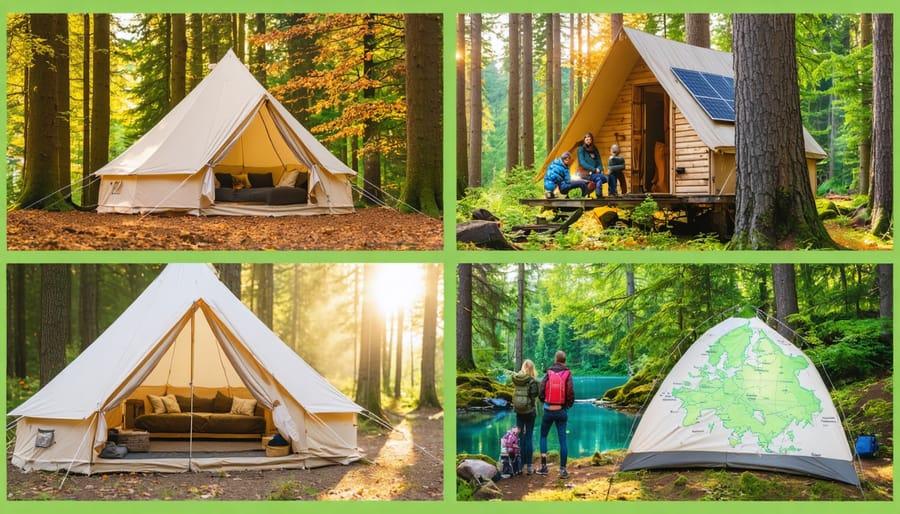







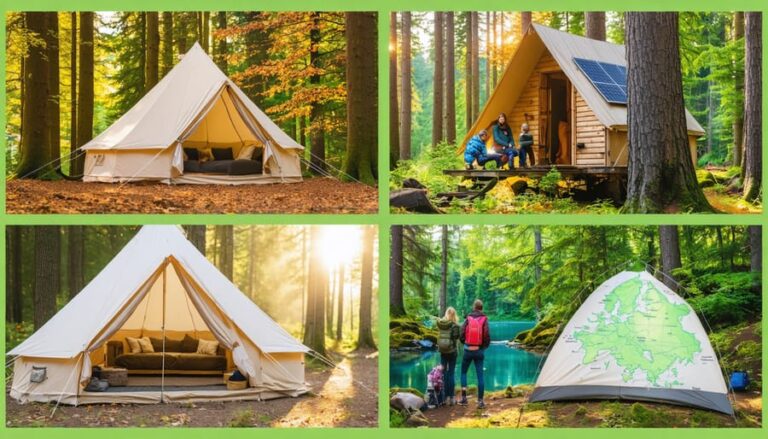




+ There are no comments
Add yours